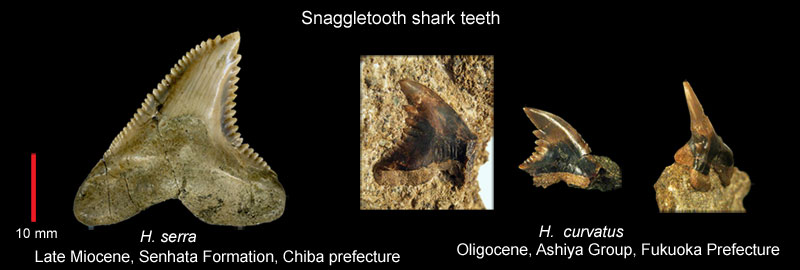| Compagno (1988) found that recent immature Snaggletooth shark teeth are different from those of mature shark not only in size but also in serrations, and suggested a similarity to those of Eocene shark H. curvatus. This page shows the dentitions of both mature and immature snaggletooth shark, and comparison between those shark teeth and fossil snaggletooth shark teeth from the Oligocen of Aino-shima, the Ashiya Group and the Miocene of Kyonan, the Senhata Formation. |


| Fig.1. Recent Snaggletooth shark (Hemipristis elongata) dentitions. A, mature, lingual view; B, immature, lingual view. Teeth of immature snaggletooth shark bear less numbers of serrations especially on the mesial cutting edge compared to those of mature shark. |

| Fig. 2-1. Fossil snaggletooth shark teeth. H. serra from the Late Miocene of Kyonan and H. curvatus from the Oligocene of Aino-shima. |

| Fig. 2-2. Silhouettes of fossil and recent snaggletooth sharks |

| Fig. 2-3. Snaggletooth shark teeth; actual sizes shown in black silhouettes. |
| The recent immature snaggletooth shark show a different type of teeth from those of the mature snaggletooth shark, which reach a maximum body length of about from 230 to 240 cm (FAO). Teeth of snaggletooth shark increase in size and in the number of serrations with age. Fossil teeth from the Oligocene of Ashiya show almost the same size as those of recent adult snaggletooth shark while the degree of serration is almost the same as those of immature snaggletooth shark, and are referable to H. curvatus. H. serra , known as a shark with developed serrations from the Miocene, seem to have no significant difference in the development of serrations to those of recent snaggletooth shark. The difference in development of tooth serrations possibly depend on the difference in size of trunk only. |
Back & Forth